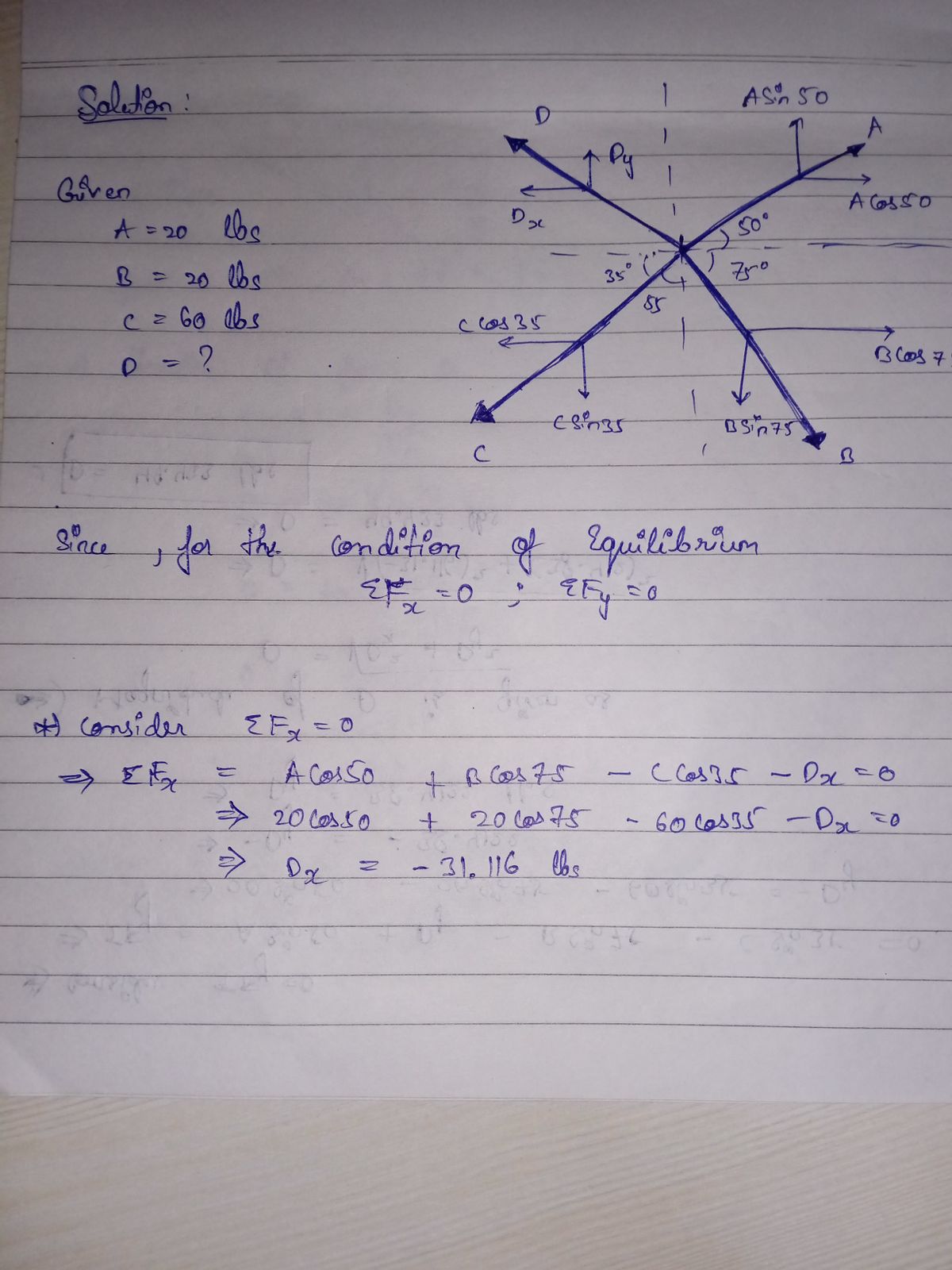
Elements Of Electromagnetics
7th Edition
ISBN: 9780190698614
Author: Sadiku, Matthew N. O.
Publisher: Oxford University Press
expand_more
expand_more
format_list_bulleted
Question
![# Diagram Explanation
The diagram illustrates four forces, labeled A, B, C, and D, represented as vectors originating from a common point. The angles between the vectors are marked to illustrate their directions in the plane:
- **Force A** (Red): Directed at an angle of 50° from the positive x-axis.
- **Force B** (Blue): Directed at an angle of 75° from the negative y-axis.
- **Force C** (Green): Directed at an angle of 55° from the negative x-axis.
- **Force D** (Black): The direction of force D is indicated but its exact angle and magnitude are to be determined.
# Solution
Determine the magnitude and direction of force **D** required for equilibrium if the forces act in the directions shown and have magnitudes:
- \( A = 20 \, \text{lbs} \)
- \( B = 20 \, \text{lbs} \)
- \( C = 60 \, \text{lbs} \)
\[ D = \boxed{\phantom{0}} \]
acting at an angle of \(\boxed{\phantom{0}}\) measured \(\boxed{\phantom{0}}\) from the \(\boxed{\phantom{0}}\).](https://content.bartleby.com/qna-images/question/799db758-6264-477e-875f-1cfecc426da7/b62d5274-7364-4dc2-b55c-9f0923ac46ac/4u6v4g_thumbnail.png)
Transcribed Image Text:# Diagram Explanation
The diagram illustrates four forces, labeled A, B, C, and D, represented as vectors originating from a common point. The angles between the vectors are marked to illustrate their directions in the plane:
- **Force A** (Red): Directed at an angle of 50° from the positive x-axis.
- **Force B** (Blue): Directed at an angle of 75° from the negative y-axis.
- **Force C** (Green): Directed at an angle of 55° from the negative x-axis.
- **Force D** (Black): The direction of force D is indicated but its exact angle and magnitude are to be determined.
# Solution
Determine the magnitude and direction of force **D** required for equilibrium if the forces act in the directions shown and have magnitudes:
- \( A = 20 \, \text{lbs} \)
- \( B = 20 \, \text{lbs} \)
- \( C = 60 \, \text{lbs} \)
\[ D = \boxed{\phantom{0}} \]
acting at an angle of \(\boxed{\phantom{0}}\) measured \(\boxed{\phantom{0}}\) from the \(\boxed{\phantom{0}}\).
Expert Solution
arrow_forward
Step 1

Step by stepSolved in 3 steps with 3 images

Follow-up Questions
Read through expert solutions to related follow-up questions below.
Follow-up Question
I tried the degree both 51 and 50.99 but it is incorrect. Plz help.
Solution
by Bartleby Expert
Follow-up Questions
Read through expert solutions to related follow-up questions below.
Follow-up Question
I tried the degree both 51 and 50.99 but it is incorrect. Plz help.
Solution
by Bartleby Expert
Knowledge Booster
Learn more about
Need a deep-dive on the concept behind this application? Look no further. Learn more about this topic, mechanical-engineering and related others by exploring similar questions and additional content below.Similar questions
- The weight of the lamp is 77 lb. Determine the following - Tension in cable CD is: _lb - Tension in cable DE is: _lb - Tension in cable AC is: _lb - Tension in cable BC is: _lbarrow_forwardDetermine the resultant support reaction at A.arrow_forwardQ.3) The cable shown below is supported by two pins at A and B. The maximum cable tension due to the applied forces is 1000 lb. Determine the tensions in all four segments of the cable and the sags of the load points P1, P2, and P3. В 5 ft- 3 ft А. 2 ft 4 ft 6 ft P3 P1 y V P2 300 lb 100 lb 200 lbarrow_forward
- Q2. Determine the stretch in each spring for equilibrium of the block of mass M. The springs are shown in the equilibrium position Given: M = 2 kg a - 3 m b = 3 m C - 4 m kAB - 30 kAC = 20 kAD - 40 g- 9.81 www Darrow_forwardنقطة واحدة The box shown in fig weighs 400 N, in equilibrium Determine the tension in the cords AB and * BC 60° B 30° 750 Narrow_forwardAlso, determine the y-component and the z-component of the tension force T. Express your answer in units of kN.arrow_forward
arrow_back_ios
arrow_forward_ios
Recommended textbooks for you
 Elements Of ElectromagneticsMechanical EngineeringISBN:9780190698614Author:Sadiku, Matthew N. O.Publisher:Oxford University Press
Elements Of ElectromagneticsMechanical EngineeringISBN:9780190698614Author:Sadiku, Matthew N. O.Publisher:Oxford University Press Mechanics of Materials (10th Edition)Mechanical EngineeringISBN:9780134319650Author:Russell C. HibbelerPublisher:PEARSON
Mechanics of Materials (10th Edition)Mechanical EngineeringISBN:9780134319650Author:Russell C. HibbelerPublisher:PEARSON Thermodynamics: An Engineering ApproachMechanical EngineeringISBN:9781259822674Author:Yunus A. Cengel Dr., Michael A. BolesPublisher:McGraw-Hill Education
Thermodynamics: An Engineering ApproachMechanical EngineeringISBN:9781259822674Author:Yunus A. Cengel Dr., Michael A. BolesPublisher:McGraw-Hill Education Control Systems EngineeringMechanical EngineeringISBN:9781118170519Author:Norman S. NisePublisher:WILEY
Control Systems EngineeringMechanical EngineeringISBN:9781118170519Author:Norman S. NisePublisher:WILEY Mechanics of Materials (MindTap Course List)Mechanical EngineeringISBN:9781337093347Author:Barry J. Goodno, James M. GerePublisher:Cengage Learning
Mechanics of Materials (MindTap Course List)Mechanical EngineeringISBN:9781337093347Author:Barry J. Goodno, James M. GerePublisher:Cengage Learning Engineering Mechanics: StaticsMechanical EngineeringISBN:9781118807330Author:James L. Meriam, L. G. Kraige, J. N. BoltonPublisher:WILEY
Engineering Mechanics: StaticsMechanical EngineeringISBN:9781118807330Author:James L. Meriam, L. G. Kraige, J. N. BoltonPublisher:WILEY

Elements Of Electromagnetics
Mechanical Engineering
ISBN:9780190698614
Author:Sadiku, Matthew N. O.
Publisher:Oxford University Press

Mechanics of Materials (10th Edition)
Mechanical Engineering
ISBN:9780134319650
Author:Russell C. Hibbeler
Publisher:PEARSON

Thermodynamics: An Engineering Approach
Mechanical Engineering
ISBN:9781259822674
Author:Yunus A. Cengel Dr., Michael A. Boles
Publisher:McGraw-Hill Education

Control Systems Engineering
Mechanical Engineering
ISBN:9781118170519
Author:Norman S. Nise
Publisher:WILEY

Mechanics of Materials (MindTap Course List)
Mechanical Engineering
ISBN:9781337093347
Author:Barry J. Goodno, James M. Gere
Publisher:Cengage Learning

Engineering Mechanics: Statics
Mechanical Engineering
ISBN:9781118807330
Author:James L. Meriam, L. G. Kraige, J. N. Bolton
Publisher:WILEY